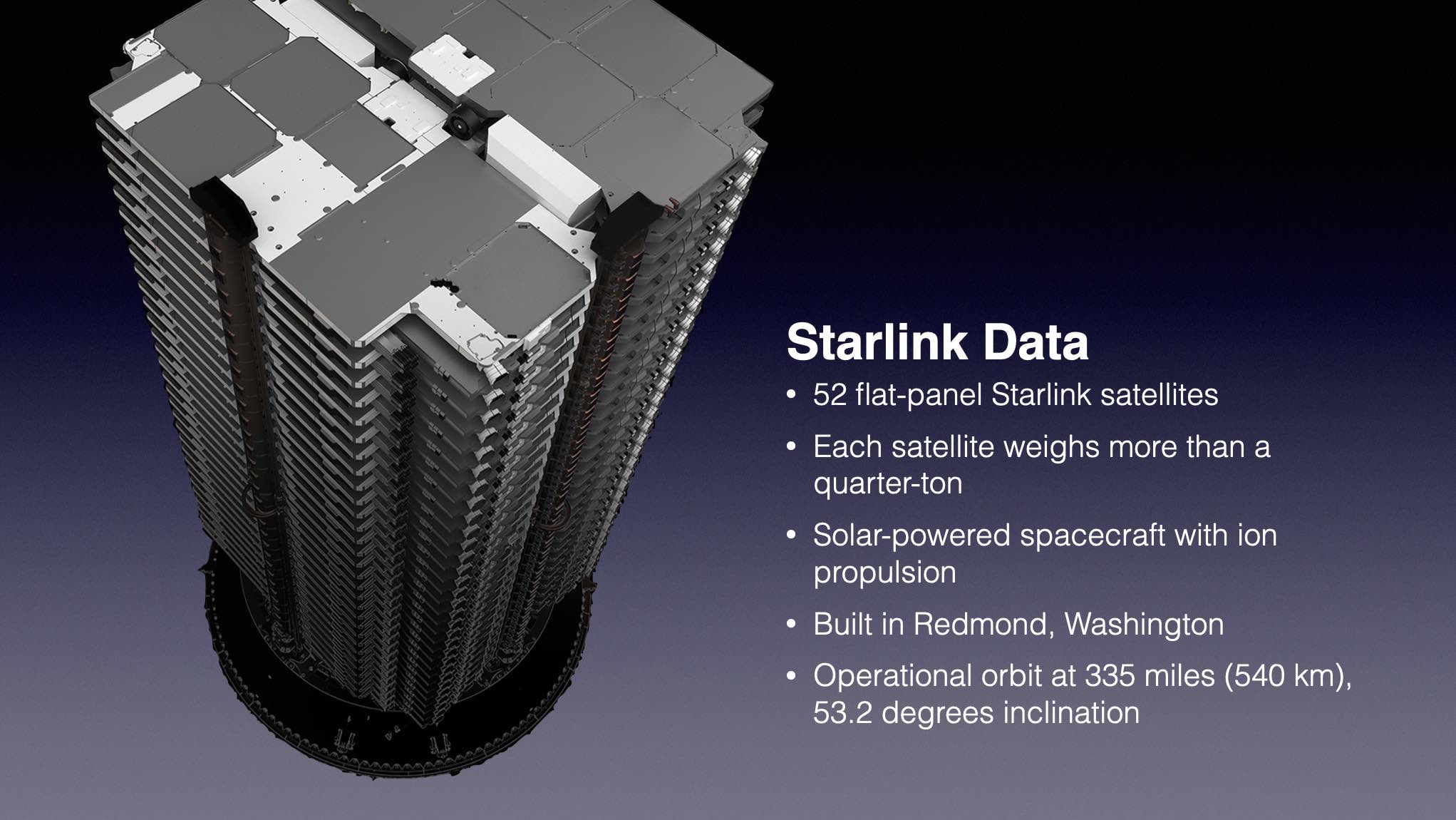Space News & Blog Articles
Falcon 9 rocket deploys SpaceX’s 3,000th Starlink internet satellite
 This long exposure photo shows SpaceX’s Falcon 9 rocket streaking into the sky over the Kennedy Space Center Tuesday night. Credit: Michael Cain / Spaceflight Now / Coldlife Photography
This long exposure photo shows SpaceX’s Falcon 9 rocket streaking into the sky over the Kennedy Space Center Tuesday night. Credit: Michael Cain / Spaceflight Now / Coldlife Photography
Fifty-two satellites are on the way to join SpaceX’s Starlink internet network after a sky-lighting blastoff from the Kennedy Space Center Tuesday night, a mission that included the 3,000th spacecraft to launch for the Starlink constellation.
The 229-foot-tall (70-meter) Falcon 9 rocket lifted off from pad 39A at the Kennedy Space Center at 10:14:40 p.m. EDT Tuesday (0214:40 GMT Wednesday). The rocket’s nine Merlin 1D main engines flashed to life and the Falcon thundered into a moonlit sky over Florida’s Space Coast, heading northeast to line up with an orbital plane in SpaceX’s Starlink network.
The rocket accelerated through the speed of sound about one minute into the flight, then continued downrange until the Falcon 9’s first stage shut off its nine Merlin engines just shy of the two-and-a-half minute point of the mission. The 15-story-tall first stage separated from the Falcon 9’s upper stage, then pulsed cold gas thrusters and extend titanium hypersonic grid fins to prepare for the searing plunge back into the atmosphere.
A restart of three of the Merlin main engines slowed the rocket down as it descended into thicker air, then a final landing burn with the center engine allowed the booster to brake for touchdown on a drone ship parked in the Atlantic Ocean a few hundred miles east of Charleston, South Carolina.
Landing of the first stage on the drone ship “A Shortfall of Gravitas” completed the booster’s third flight to space. The Falcon 9 first stage, designated B1073 in SpaceX’s inventory, debuted in May and notched a second flight in June.
The Falcon 9’s single-use upper stage continued into orbit with a six-minute burn of its single Merlin engine, which cut off around the same time as the first stage booster landed on SpaceX’s drone ship. The Falcon 9’s reusable payload fairing jettisoned during the second stage burn. A recovery ship was also on station in the Atlantic to retrieve the two halves of the nose cone after they splashed down under parachutes.
A SpaceX Falcon 9 rocket took off from Florida’s Space Coast at 10:14pm EDT (0214 GMT), carrying 52 more Starlink internet satellites into orbit.
The mission will push the Starlink fleet beyond the mark of 3,000 satellites launched.https://t.co/9F0Ebnbkmb pic.twitter.com/YifvYnP2Rk
— Spaceflight Now (@SpaceflightNow) August 10, 2022
The upper stage was programmed to deploy the 52 Starlink satellites at T+plus 15 minutes, 24 seconds. The rocket targeted an orbital altitude between 144 miles and 208 miles (232-by-335 kilometers).
The Starlink satellites separated from the Falcon 9’s upper stage after it released four retention rods that held the spacecraft to the rocket during launch. SpaceX’s launch team confirmed the deployment of the satellites into an on-target orbit.
The satellites will deploy their power-generating solar arrays and use ion engines to climb to an altitude of 335 miles (540 kilometers). The orbit-raising maneuvers typically take a few weeks to a few months, depending on the orbital plane targeted for each spacecraft.
With the new satellites launched Tuesday night, SpaceX has lofted 3,009 Starlink satellites into orbit on Falcon 9 rockets, including prototypes and earlier spacecraft designs no longer in service. The launch Tuesday was the 54th Falcon 9 flight primarily dedicated to carrying Starlink satellites into orbit.
A tabulation by Jonathan McDowell, an astrophysicist and expert tracker of spaceflight activities, shows there are 2,662 Starlink satellites functional in orbit, as of Tuesday. The network has a 2,268 satellites operational providing consumer broadband services, and the rest are maneuvering into the final orbital positions, according to McDowell.
SpaceX more than halfway through the build-out of its first-generation Starlink network, which will number around 4,400 active satellites spread out in five orbital “shells,” according the company’s filings with the Federal Communications Commission.
 Credit: Spaceflight Now
Credit: Spaceflight Now
The Starlink satellites use laser inter-satellite links to facilitate data transfers in orbit, without needing to relay signals through ground stations, which come with geographical, and sometimes political, constraints. Laser crosslinks can also reduce latency in the Starlink network because signals need to travel a shorter distance.
SpaceX won approval from the Federal Communications Commission in June to begin offering Starlink connectivity to mobile customers. So far, Starlink services have focused on fixed customers, such as homes, businesses, and schools.
The company announced last month it will offer Starlink internet for customers on boats, yachts, oil rigs, and other users in the maritime market. Several airlines have tested or agreed to use Starlink connectivity on aircraft to provide in-flight WiFi for passengers.
The launch Tuesday night, designated Starlink 4-26, was SpaceX’s 35th Falcon 9 mission of the year, and the 169th launch of a Falcon 9 rocket overall.
The next Falcon 9 launch is scheduled for Friday from Vandenberg Space Force Base in California with another group of Starlink internet satellites heading one of the network’s polar orbit shells. That will be followed by another Falcon 9 launch for the Starlink network set for Aug. 16 from Cape Canaveral Space Force Station.
This email address is being protected from spambots. You need JavaScript enabled to view it. the author.
Follow Stephen Clark on Twitter: @StephenClark1.
When you subscribe to the SpaceZE News Feed, we will send you an e-mail when there are new updates on the site so you wouldn't miss them.

